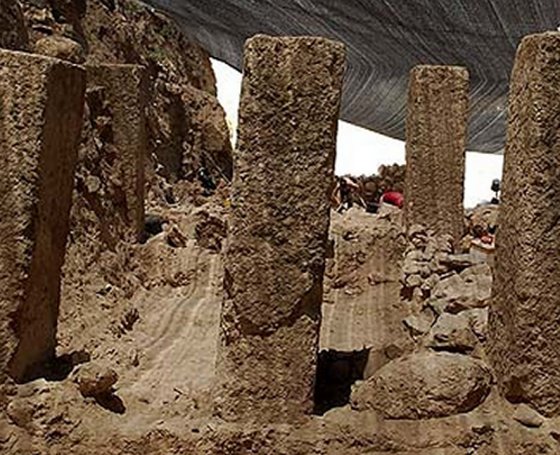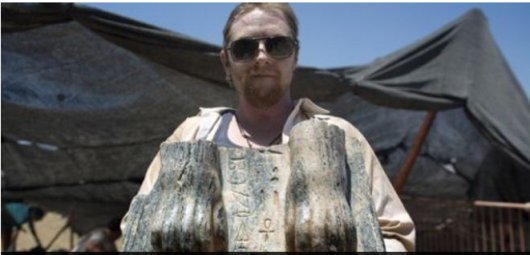MessageToEagle.com – Archeological excavations at Tel Hazor, North Of The Sea Of Galilee, have revealed an unexpected find.
However, it’s not the first discovery in this region of the Biblical land of Israel.
During diggings (1955-58), Israeli archaeologist Yigael Yadin (1917 – 1984) discovered the six chamber gate complex dated to the time of Solomon’s building projects. Yadin related this pattern of structures to the Old Testament text that mentions specifically Hazor, Megiddo and Gezer as administrative centers (or chariot cities) built and/or rebuilt by Solomon.
“And this is the reason of the levy which king Solomon raised, to build the house of Jehovah (YHWH), and his own house, and Millo, and the wall of Jerusalem, and Hazor, and Megiddo, and Gezer.” we read in 1Kings 9:15.

Now, a part of a unique Sphinx statue – only the paws and some of the mythical creature’s forearms – inscribed with name of King Mycerinus who ruled Egypt more than 4,000 years ago, has been unearthed by Hebrew University archaeologists led by Prof. Amnon Ben-Tor and Dr. Sharon Zuckerman.

“Once in a lifetime you find something like this,” says Amnon Ben-Tor, the director of the excavation and a professor at Hebrew University, which sponsors the archeological digging.
“This is of extreme importance from many points of view, since it is the only sphinx of this king known in the world — even in Egypt. It is also the only monumental piece of Egyptian sculpture found anywhere in the Levant,” he said, referring to the region spanning the east of the Mediterranean Sea.
King Mycerinus was responsible for the construction of one of the great pyramids in Giza.
It’s a clear evidence of famous Egyptian rule in Tel Hazor – home to one of the most significant cities in ancient times due to its designation as a major trade route in the Near East.
Tel Hazor is also rich in biblical history, as the land was first conquered by Joshua and later became the chief city of King Solomon.
The Sphinx was discovered in the layer of Tel Hazor that was destroyed during the 13th century BCE, at the entrance to the city palace.
The hieroglyphic inscription found between the toes includes the descriptor “Beloved by the divine manifestation… that gave him eternal life.” Ben-Tor and Dr. Zuckerman believe that this indicates the likelihood that the Sphinx originated in the ancient city of Heliopolis, not far from modern Cairo.
The sphinx was deliberately broken. Researchers have previously found about 10 other Egyptian statues in the same area. Most of the statues had their heads and hands cut off. “This is what happened to this one here. He lost his hands,” Ben-Tor said. The full sphinx is estimated to have been a meter tall, weighing half a ton.
The team will continue to search for the rest of its body on the archeological site covering 200 acres — even if it takes 600 years, the length of time Ben-Tor expects for the site to be fully excavated.
According to the archaeologists, it is highly unlikely that the Sphinx was brought to Hazor during the time of Mycerinus, since there is no record of any relationship between Egypt and Israel in the third millennium BCE.
More likely, the statue was brought to Israel in the second millennium BCE during the dynasty of the kings known as the Hyksos, who originated in Canaan.
It could also have arrived during the 15th to 13th centuries BCE, when Canaan was under Egyptian rule, as a gift from an Egyptian king to the king of Hazor, which was the most important city in the southern Levant at the time.
Hazor is the largest biblical-era site in Israel. In the second millennium BCE, Hazor is estimated to have been about 20,000, making it the largest and most important city in the entire region. Its size and strategic location on the route connecting Egypt and Babylon made it “the head of all those kingdoms” according to the biblical book of Joshua (Joshua 11:10).
See also:
Mystery Of The Sphinx – A Guardian Of Knowledge And Symbol Of Riddles And Intrigue
Hazor’s conquest by the Israelites opened the way to the conquest and settlement of the Israelites in Canaan. The city was rebuilt and fortified by King Solomon and prospered in the days of Ahab and Jeroboam II, until its final destruction by the Assyrians in 732 BCE.
MessageToEagle.com






